
Proudly supported by:

 |
Women's racing is experiencing a huge boom and one rider that has long been at the forefront of it is Starla Teddergreen. Starla began her racing career on the streets as a bike messenger in Seattle before moving to San Francisco in 2003. Known for her sprinting prowess, she worked her way up the ranks and in 2010 joined the women's professional team Vanderkitten. 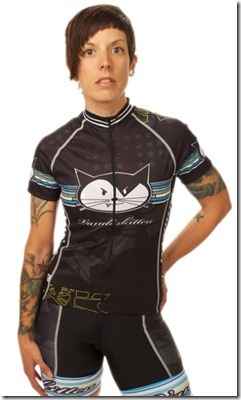 | | Starla strikes a pose | The road to pro cycling wasn't easy for Starla. Growing up in a quiet northeast Washington town, she had virtually no opportunities for racing (besides the ones her somewhat disinterested sister occasionally provided). She soon found competitive outlets in running and soccer, but it was her move to Seattle after high school that changed everything. With no experience, but with a load of her trademark enthusiasm, Starla found a job as a bike courier. Two wheels suited her well, and the excitement of the job led her to to explore Seattle's alleycat racing scene and, eventually, to the Cycle Messenger World Championships. A move to San Francisco in 2003 introduced her to road racing and planted the seed for her future as a pro athlete. With her knack for reading a race and a fantastic sprint, Starla quickly moved up the amateur ranks, landing on the elite SugarCRM team for 2009. This led to her debut in the NRC Series as well as to a month of kermesse racing in Belgium, where she was able to sneak into the top 10 in what is known as some of the world's toughest racing. 2010 brought with it mixed fortunes. Starla began to mature as a rider, landing a spot on the Vanderkitten Professional team. A solid entry to the NRC Series was cut short when she ended up at the bottom of a huge finishing crash at the Tour de Nez. The hip injury that resulted was to plague Starla throughout the 2011 season. This didn't stop her taking home a few wins, but by autumn it became clear that, without intervention, the injury was not going to get sorted out. In the winter of 2011, it was determined that Starla had a torn labrum and that surgery and a long rehabilitation period were required. This is where Starla's maturity really shone. Instead of trying to rush her rehab and bike training program as so many athletes do, she showed the patience and dedication of a real professional and by April was back on the bike. It took the better part of 2012 to be able to train and race without pain. During her recovery, she was able to indulge her enthusiasm for supporting women's racing by riding as a team mentor for the Early Bird Women's Developmental Team. 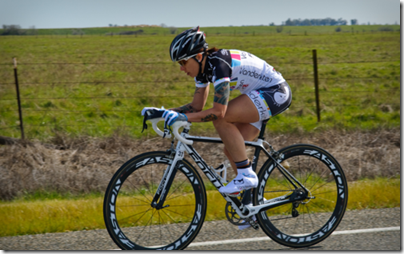 | | Starla digging deep | With the 2012 comeback season under her belt, Starla has high hopes and solid goals in 2013. In her own words, she wants to "win races and/or a race series, support a GC rider to victory, and stand out to be a rider with potential to race successfully in Europe again." Find out more about Starla here: www.starlateddergreen.com and her graphic design and bike fitment work here: http://starladesign.com/ and here: http://teddergreen.com
Cyclocross is great training for cycling and in endurance coaching circles, widely respected as not only a winter training sport, but a specialty in and of itself. It is technique-heavy, as cycling disciplines go, so it's a good place for roadies and the like to keep their skills sharp. A few weeks ago, we covered the basics of cyclocross training and technique. Now, we'll delve into one of the more difficult aspects of technique - dismounting, carrying and getting back onto your bike. Of course, the best way to learn this is with the hands-on instruction of a coaching ride. The key to developing good bike handling skills is to practice being smooth and relaxed. Your dismount, transition to carry, return of the bike to the ground, and remount should feel like one fluid motion. At first, it will likely feel like the opposite, but this smoothness is something to strive for. Let's go over the specifics: Dismounts: The key to dismounts, like comedy (which sometimes results), is timing. The speed of approach, type of obstacle, and traction conditions all play a role in deciding when to dismount. It's generally best to ride as close to the obstacle as practical, or in the case of a run-up as far up it as practical. Some riders like to set their brakes up "Italian-style," with the rear brake on the left, so that they can eliminate the chance of locking the front wheel in loose terrain while they are halfway off the bike. Let's outline the steps, one at a time: - Gauge your speed appropriately and slow down smoothly as you approach the obstacle
- Swing your right leg over the saddle and bring it behind your left leg
- Square your hips with the handlebars - perpendicular to the frame of the bike
- As you continue to slow down, release your right hand from the handlebar and grab your top tube, pushing your weight into it to offload weight from your feet
- Twist your left foot free of the pedal as you land on your right foot first (behind your left foot). Alternatively, you can "step-through"- instead of planting your right foot behind the pedal, step between your left leg and the bike and land in a run with your right foot in front.
- Pick up your bike!
 | | The dismount. Notice the weighted hand on the top tube | Carry: There are two main ways to carry your bike: the "suitcase" carry and the shoulder carry. For short sets of barriers or stairs, the suitcase usually will suffice. For longer run-ups and triple barriers, it's better to shoulder your bike. Suitcase-style Carry: This one is easy. Once you have stepped off your bike, with your left hand on the brake hood and your right hand on the top tube, simply pick the bike up, like a suitcase. It's best to avoid the temptation to tuck it close to your body. You can love your bike, but this is a good time to keep it at arm's length. Also, you only need to lift it high enough to clear the obstacle. Riders often lift their bikes higher than necessary, thereby wasting valuable energy. As long as the wheels clear the obstacle, that's enough. 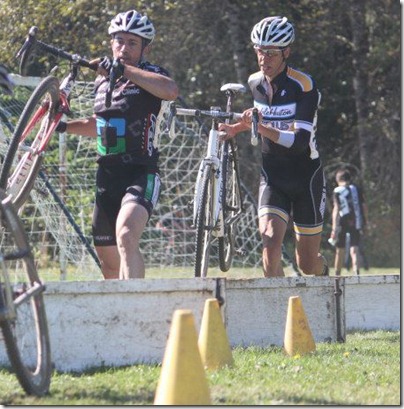 | | The rider in front is lifting his bike higher than necessary, while the second rider just clears the barrier – saving a bit of energy along the way | Shoulder Carry: This one is slightly more complicated, but still not hard. The dismount is very similar to the above, unless it's really smooth, in which case you may be able to skip grabbing the top tube and simply pick the bike up by the down tube as you dismount. - Gauge your speed appropriately and slow down smoothly as you approach the obstacle
- Swing your right leg over the saddle and bring it behind your left leg
- Square your hips with the handlebars - perpendicular to the frame of the bike
- As you continue to slow down, release your right hand from the handlebar and grab your top tube, pushing your weight into it to offload weight from your feet
- Twist your left foot free of the pedal as you land on your right foot
- As you begin to run, release the top tube, reach down on your side of the bike, and pick up your bike by the down tube. Slide the top tube up your arm to rest on your shoulder with your arm under the down tube. Do this in one smooth motion, ending with your right hand holding the bottom of the handlebar
- Tuck your right hand into your chest - this will keep your saddle from hitting your helmet
- Run, using your left hand for balance if necessary.
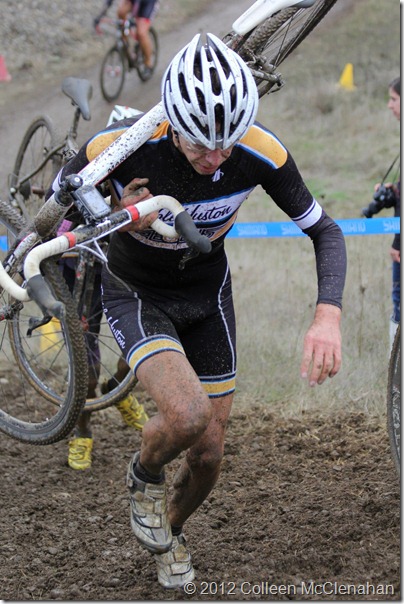 | | Running with the bike on the shoulder. Notice how the right arm is wrapped under the down tube and the hand holds the end of the handlebar | Remount: This is basically an exaggerated "step" onto the bike. Ideally, it is less of a jump and more of a smooth slide over the bike and back into the pedals. The key to this, as with the above, is to be as smooth and fluid as possible. Here is the breakdown: - After placing your bike back on the ground as smoothly as possible while you run, step off your left foot as you begin to bring your right leg over the saddle
- Envision simply placing your right foot back into the right-side pedal. Aim for it
- Slide your right thigh over the saddle, still aiming for the pedal with your foot
- Find your pedals, clip in, and keep pedaling!
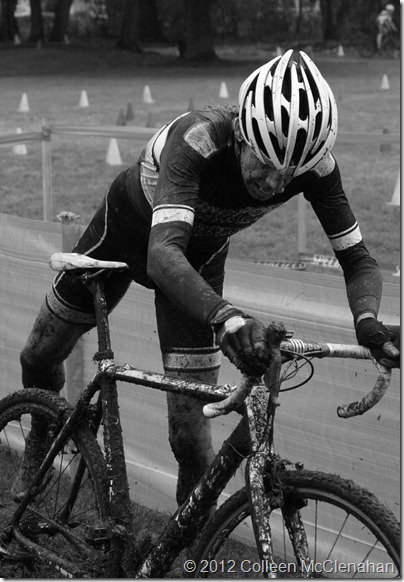 | | Stepping onto the bike. It doesn't look like I am running in this photo, but I am! | 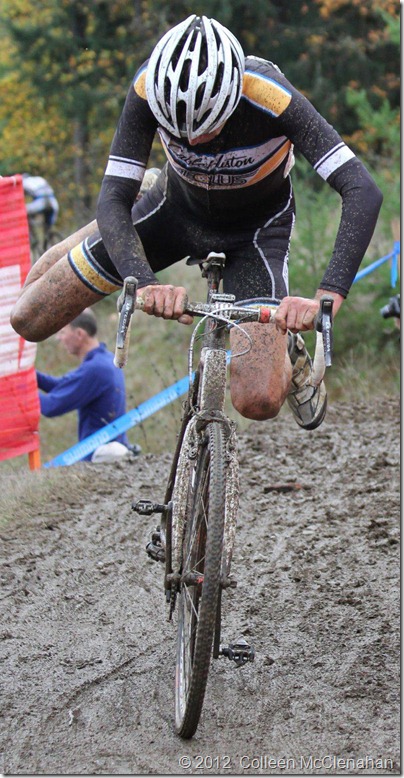 | | Sliding into the saddle | All of these techniques require practice to master. You will know you have it right when you're racing and not even thinking about the next obstacle or what you are going to do to get over it. Focus on staying relaxed and strive for smoothness and fluidity. The smoother you are, the faster you will be.
Barton Park is always a fun day out. Despite (or, perhaps because of) being held in a gravel pit and adjoining county park, the venue offers a host of challenges for cyclocross racers. There is deep mud, shallow mud, gravel, pavement, puddles like small lakes, steep drops and two run-ups that feature a unique mix of mud and somewhat large stones! I showed up feeling a bit off my game and, having missed too many Cross Crusade races to score points, started at the back of the 70-strong field. My teammate Brook and I had a nice warmup spin, but we kept it short as the temperature was approaching 70 F degrees already – unusual for Oregon in November. Barton is a fast course, and so it is tough to start at the back and have any hope of making up a lot of places. Despite this, I got a decent start and really made sure to relax and not give too much in the first laps. This strategy paid off as I began to feel much better later in the race. Once the field thinned, I gradually caught several small groups of riders. On the last lap, I put in a hard effort over the triple barriers and got a gap on the group I was with, which I managed to keep to the finish. This was enough to net me 19th place on the day – one spot out of the points. Normally, this would be a bit frustrating, but with having arrived feeling a bit unfocused and starting at the back, I'm happy about it. Sadly, there is no data to report or analyze, as my Garmin decided to take a holiday. Although it showed the data on-screen during the race, it did not record any of it. Here are some photos from the day: 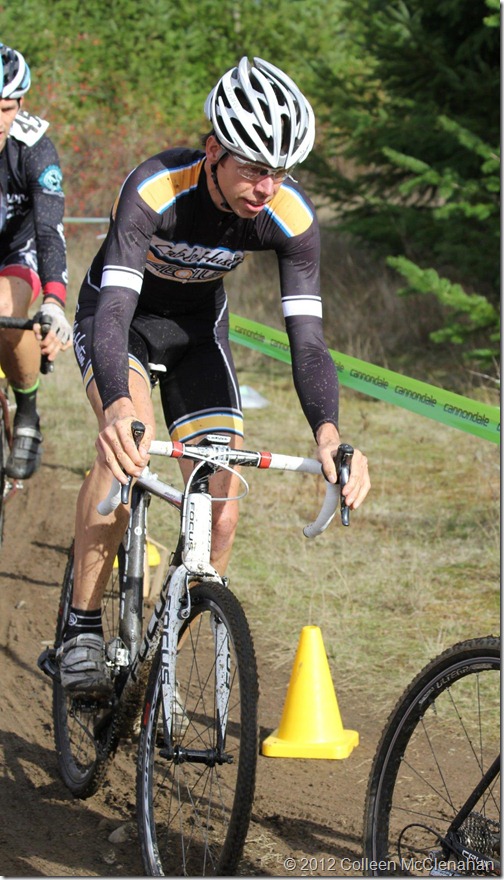 | | In the beginning, the sun shone | 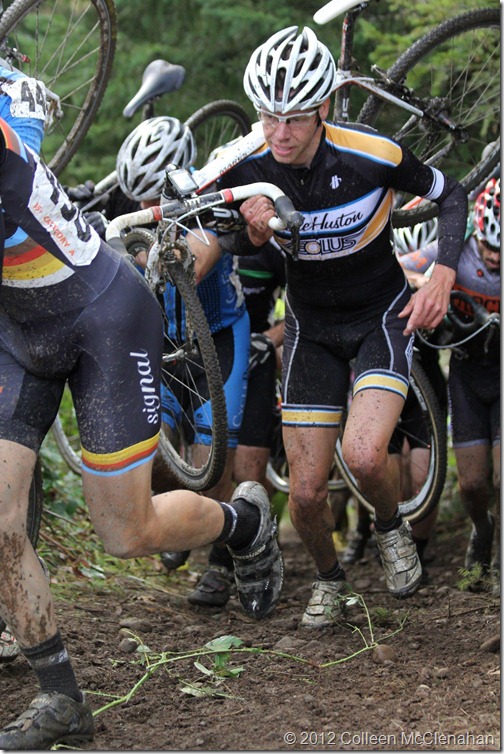 | | It was hectic the first time up the second run-up | 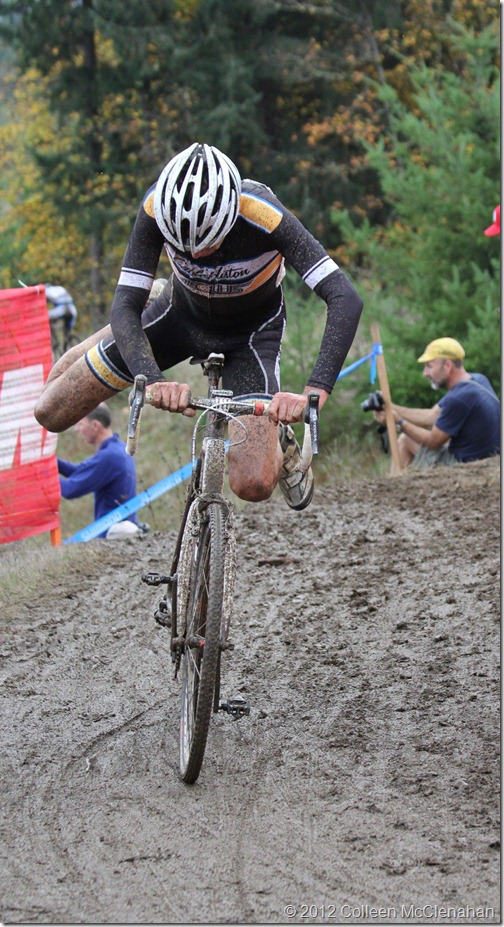 | | Remounting at the top of the first run-up |  | | I'm beginning to get used to this running thing | 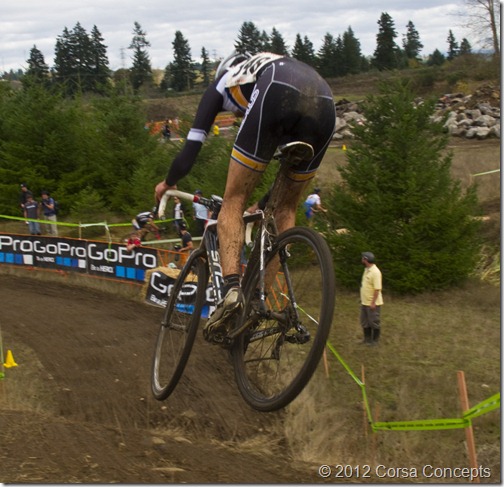 | | It's faster to ride, but it's more fun to fly… |
© 2025 Aeolus Endurance Sport
|













